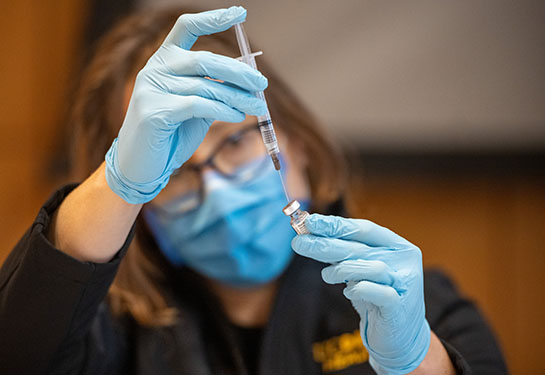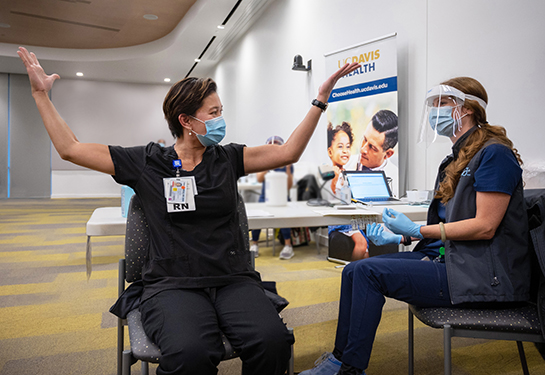A tripledemic expected this winter
RSV, flu and COVID-19 are coming
Just when we thought the worst of the COVID-19 pandemic was over, experts are warning that a tripledemic is heading our way this winter. This trio of viral threats includes respiratory syncytial virus (RSV), influenza (flu) and COVID.
Many children’s hospitals in other parts of the country are already experiencing a surge, fueled by a spike in respiratory viruses, leaving them with no free beds.
"COVID cases are expected to rise during the winter. This will be occurring at the same time we expect to see influenza rates increase while we are already seeing an early start to RSV season,” said Dean Blumberg, chief of pediatric infectious diseases at UC Davis Children’s Hospital. “With all three viruses on the rise, we are worried about an increase in the rates of viral infection that may lead to an increase in hospitalizations.”
We asked Blumberg about ways to keep ourselves and our families safe this winter.
What symptoms should we look out for?
With COVID-19, symptoms include:
- fever or chills
- respiratory symptoms (cough, sore throat, runny nose)
- loss of taste and smell
- fatigue
- sore throat
- muscle or body aches
- headache
Influenza (flu) is typically defined by a really rapid onset. You might be feeling fine one minute, then all of a sudden, you feel like you were hit by a freight train. You can expect:
- fever or chills
- respiratory symptoms (cough, sore throat, runny nose)
- muscle aches and pains
- headaches
Children tend to have more stomach symptoms with influenza – stomachache, vomiting and diarrhea - compared to RSV and COVID.
RSV results in runny noses and frequent sneezing, but it’s generally a milder infection compared to flu and COVID. Other RSV symptoms include:
- coughing
- fever
- wheezing
- decrease in appetite
In order to confirm which virus is causing infection, a nasal swab test would need to be ordered by your primary care physician.
What is RSV?
RSV is a common upper respiratory infection that circulates in the community every year. Some people may even get it twice a year.
Children are generally infected in the first 3 years of life, and reinfection is common. It’s primarily spread via respiratory droplets when a person coughs or sneezes.
But the following groups are at higher risk for getting more severe RSV, resulting in hospitalization:
- young children
- children born prematurely or born with other congenital health conditions
- the elderly
If your child is having trouble breathing, their lips are turning blue, or their ribs are sticking out when they are breathing, then you should bring them to the emergency department.
An estimated 58,000 children under 5 years old are hospitalized from RSV every year, according to the Centers for Disease Control and Prevention.
What are the treatment options for RSV?
Children can get supportive care. They may receive oxygen to help them breathe. Some children work so hard on their breathing that they may fall behind on their fluids and get dehydrated.
For children most vulnerable to severe infection, there is a monoclonal antibody preventative injection, palivizumab, that is given once per month during the RSV season to prevent infection. But there’s only a small number of children who qualify.
There is no vaccine available for RSV. However, RSV vaccines are in development and might be available in the next few years.
Why did we not see a tripledemic last winter?
Last year, we still had more masking in place and social distancing, so we didn’t have the increased risk of transmission in the same way. RSV rates increased this summer, which is early, but they didn’t reach a very high rate.
We did see a large increase of influenza this year in the southern hemisphere during their winter, which is our summer. In Australia, influenza rates were greater than anytime seen in the last 10 years. They were three times greater than normal. This is usually predictive of what we’re going to see in the U.S. We’re worried that it will be a bad influenza year and a bad RSV year, on top of COVID.
What should we expect to see with COVID-19 this winter?
Well, we got through the Omicron period and the latest BA4/BA5 wave. The models suggest that we are going to see an increase in cases this winter and that’s to be expected because COVID is part of the coronavirus family, which peaks during the winter months. The humidity and the temperature favor viral survival. That’s why we do expect an increase in cases this winter.
The new bivalent boosters are recommended. One of the main advantages is that it combines the original and the Omicron strains, which results in a wider, more diverse immune response. Not only will this protect against currently circulating strains, but it’s expected to provide better protection against emerging variants that we haven’t even seen yet.
The side effects of the booster are very similar to the primary series and other boosters that people are already familiar with:
- Pain at the injection site
- Fever
- Fatigue
- Headache
This generally lasts a day or two. The protections are expected to be better than the previous boosters. It takes two weeks to get the full immune response.
People over 50 years of age really need their boosters since they are at an increased risk for hospitalizations and death. Also, anyone who has underlying conditions, anyone eligible for a booster, should get their booster to decrease their risk of severe disease, hospitalization and death.
What are other ways that we can stay safe?
For COVID and influenza, being vaccinated and boosted provides your best protection.
The influenza vaccine is updated yearly, aiming to include strains predicted to be circulating. So far, the strains in this year’s shot are a good match to the circulating strains, so we’re hopeful that the vaccine will provide good protection. Even if you get a breakthrough infection, you will have a milder illness, so I recommend this for everyone 6 months of age and older. You can get the COVID shot and flu shot at the same time.
Masks also protect against all of these respiratory viral infections. People who want to decrease their risk of infection can continue to mask indoors and around others outside of their household.
The standard rectangular surgical masks continue to provide about a 50% decreased risk against disease. If you want to up your game, you can wear a KN95 or an N95. These will provide about an 80% decreased risk against COVID transmission, and also decrease risk of RSV and influenza.
What about other treatments?
If people do get infected with COVID, they may want to contact their health care provider. There are a variety of available treatments. For people over 50, the oral antiviral Paxlovid can decrease their risk of hospitalization and death. Younger individuals at higher risk for severe disease may also take Paxlovid.
Monoclonal antibodies are available to treat people who may not be eligible for Paxlovid or other treatments. The monoclonal antibody, Evusheld, can be given to those who are immunosuppressed before they get infected. This is an injection that is given every six months.
For the antiviral treatment for influenza, call your health care provider within a day or two of getting flu symptoms. Getting the antiviral treatment may shorten the illness duration and can make a big difference.
Related links
What you need to know about bronchiolitis, a complication of RSV



